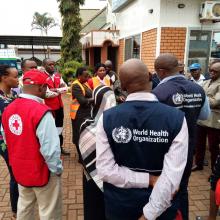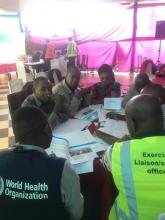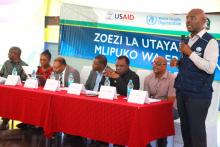WHO and partners step up preparedness to Ebola threat in two regions
The current Ebola outbreak in the Democratic Republic of Congo remains precarious, with infection transmissions continuing to occur in communities and health facilities. As of 23 July 2019 a total of 2,612 and 1, 756 deaths have been recorded. Although the number of cases have remained constant its geographical spread to Goma is of concern. As such, the United Republic of Tanzania remains at risk of cross-border transmission of Ebola, because it borders and has significant human traffic with the DRC.
No Ebola case has been recorded in the country but considering the threat of importation, the country is stepping up its preparedness efforts in the high-risk border regions in line with the WHO’s regional roadmap for response to EVD.
For two weeks, WHO and partners supported the country to conduct table top exercises and drills in Kagera and Kigoma Regions. Spearheaded by the Ministry of Health in collaboration with the Prime Minister’s Office, the simulation exercises were officially launched in Kagera by the Regional Administrative Secretary, Prof. Faustin Kamuzora.
Speaking during the launch, Prof. Kamuzora underscored the significance of the simulation exercise as an opportunity to strengthen both multisectoral and cross-sector coordination and collaboration during emergency response and preparedness. “Coordination is key. If you see a disease outbreak going on uncontained you should be sure that the local administration and not only the health sector has weakness in coordination”, he stressed.
The week-long exercises involved officials from the Ministry of Health, Prime Minister’s Office, Ministry of Livestock Development, WHO, FAO, USAID, Chemonics-HRH2030, Global Health Supply Chain, Tanzania Red Cross and Médecins Sans Frontières.
The simulation exercises that took place in Kagera and Kigoma consecutively, followed a One Health approach to coordinate the different players involved from the Regional, District and Health Facility level. They included epidemiologists, clinicians, laboratory experts, communication officers, social mobilization experts, refugee experts, logisticians, point of entry focal points and infection prevention and control experts.
The exercises tested the level of preparedness and response and assess operational capabilities at regional and district levels, including ability to apply preparedness and response frameworks for EVD and front line workers’ knowledge and skills in disease detection and case management in line with national and international clinical guidelines and protocols.
At the end of each simulation exercise, the exercise management team conducted onsite training to front line health workers to enhance their skills and confidence in surveillance, laboratory and case management in line with national guidelines and standard operation procedures. The simulation exercises are expected to enhance operational readiness and capacity of subnational response teams to respond effectively to health emergencies.



